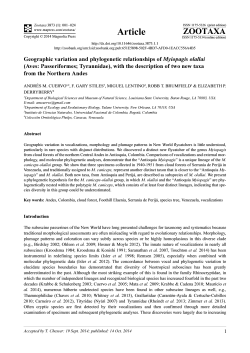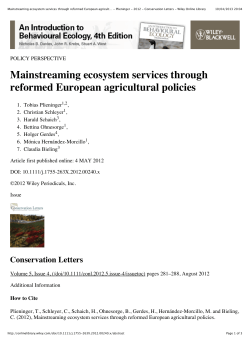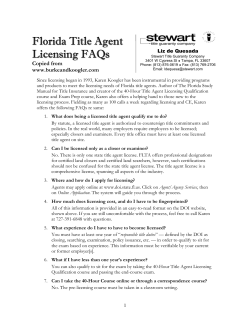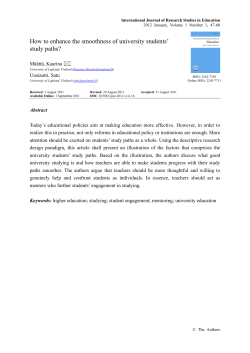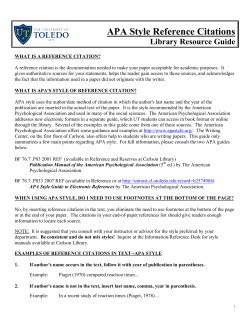
Optimal Therapy for Multidrug-Resistant
LETTERS of the publicly accessible and searchable international sequence databases such as GenBank, the European Molecular Biology Nucleotide Sequence Database, or the DNA Database of Japan so that it can be readily accessed by the scientific community. Stacy R. Finkbeiner, Binh-Minh Le, Lori R. Holtz, Gregory A. Storch, and David Wang Author affiliation: Washington University School of Medicine, St. Louis, Missouri, USA DOI: 10.3201/eid1601.091563 References 1. 2. 3. 4. Bányai K, Meleg E, Moschidou P, Martella V. Detection of newly described astrovirus MLB1 in stool samples from children [letter]. Emerg Infect Dis. 2010;16:169. Walter JE. Genetic characterization of astroviruses associated with diarrhea among children in a periurban community of Mexico City, 2002 [doctoral dissertation]. Pecs (Hungary): Medical School, University of Pecs. Finkbeiner SR, Kirkwood CD, Wang D. Complete genome sequence of a highly divergent astrovirus isolated from a child with acute diarrhea. Virol J. 2008;5:117. Finkbeiner SR, Le BM, Holtz LR, Storch GA, Wang D. Detection of newly described astrovirus MLB1 in stool samples from children. Emerg Infect Dis. 2009;15:441–4. DOI: 10.3201/ eid1503.081213 Address for correspondence: David Wang, Washington University School of Medicine, Campus Box 8230, 660 S Euclid Ave, St. Louis, MO 63110, USA; email: davewang@borcim. wustl.edu 170 Optimal Therapy for Multidrug-Resistant Acinetobacter baumannii To the Editor: I read with interest the article by Doi et al. about a lung transplant patient presumed to have Acinetobacter baumannii ventilatorassociated pneumonia (1), but some points deserve comment. A. baumannii is a relatively avirulent organism that frequently colonizes body fluids. For multidrug-resistant strains, antimicrobial drug selection is limited. Resolution of this patient’s pulmonary infiltrates suggests that they were not caused by A. baumannii that persisted in respiratory secretions. Because A. baumannii persisted in this patient’s respiratory secretions, colistin and cefepime were given. Colistin is an antimicrobial drug with low resistance potential; but when given by inhalation, it may lead to drug resistance (2,3). Doi et al. stated that the patient’s A. baumannii strain lacked susceptibility to all available antimicrobial drugs but that cefepime and tigecycline were intermediately susceptible (MICs 16 μg/mL and 2.0 μg/mL, respectively) (1). Intermediate susceptibility may also be interpreted as relatively susceptible when achievable serum or tissue concentrations exceed the MIC. The article did not mention the dosages of colistin, tigecycline, and cefepime. A 2-g dose of cefepime given intravenously results in peak serum levels of ≈163 μg/mL with a relatively low volume of distribution (0.29 L/kg), which would not be expected to eradicate A. baumannii in respiratory secretions. High-dose intravenous tigecycline (initial dose of 200 mg followed by 100 mg daily) has been used to treat A. baumannii, achieving peak concentrations of ≈3 μg/mL, which exceed the isolate’s MIC of 2 μg/mL, and a high volume of distribution (8 L/kg), which would be expected to eradicate A. baumanii in respiratory secretions. Optimal treatment for A. baumannii depends on susceptibility, pharmacokinetic principles, and site of infection. For optimal effectiveness, cefepime and tigecycline should have been given at high doses. To prevent potential resistance, antimicrobial drugs should not be given by inhalation (3). The alleged advantage of inhalation therapy is high local drug concentrations, but concentrations in some alveoli may be subtherapeutic (3). If possible, tigecycline should not be used to treat A. baumannii infections; however, if it is used, high doses should be given to optimize its pharmacokinetic attributes (4,5). Burke A. Cunha Author affiliations: Winthrop-University Hospital, Mineola, New York, USA; and State University of New York, Stony Brook, New York, USA DOI: 10.3201/eid1601.090922 References 1. 2. 3. 4. 5. Doi Y, Husain S, Potoski B, McCurry KR, Paterson DL. Extensively drug-resistant Actinetobacter baumannii. Emerg Infect Dis. 2009;15:980–2. DOI: 10.3201/ eid1506.081006 David MD, Gill MJ. Potenital for underdosing and emergence of resistance in Acinetobacter baumannii during treatment with colistin. J Antimicrob Chemother. 2008;61:962–4. DOI: 10.1093/jac/dkn009 Cunha BA. Aerosolized antibiotics are not a good idea—don’t go with the flow: primum non nocere! Crit Care Med. 2009;37:799–800. DOI: 10.1097/ CCM.0b013e3181959ba5 Cunha BA. Once daily tigecycline therapy of multidrug-resistant and non-multidrug– resistant gram-negative bacteremias. J Chemother. 2007;19:232–3. Cunha BA. Pharmacokinetic considerations regarding tigecycline for multidrugresistant Klebsiella pneumoniae or MDR Acinetobacter baumannii urosepsis. J Clin Microbiol. 2009;47:1613. DOI: 10.1128/ JCM.00404-09 Address for correspondence: Burke A. Cunha, Infectious Disease Division, WinthropUniversity Hospital, Suite 432, 222 Station Plaza North, Mineola, NY 11501, USA; email: emccaffrey@winthrop.org Emerging Infectious Diseases • www.cdc.gov/eid • Vol. 16, No. 1, January 2010 LETTERS In Response: We welcome Burke A. Cunha’s letter (1) but disagree with him regarding 4 issues. First, he states that colistin has a “low resistance potential” (1). Although colistin has had low resistance for a long time, we are concerned that development of resistance to colistin is a growing problem. Heteroresistant Acinetobacter isolates are readily found (2). Lee et al. (3) recently found decreases in polymyxin B susceptibility during therapy. Second, Cunha states, “Intermediate susceptibility may also be interpreted as relatively susceptible when achievable serum or tissue concentrations exceed the MIC” (1). We support the concepts that break points are artificial and that pharmacodynamic optimization may enable treatment for some organisms that are not susceptible to certain antimicrobial drugs. However, consideration of more than the MIC is necessary. Cefepime is a time-dependent bactericidal drug; therefore, effectiveness depends more on the time that the concentration of drug is above the MIC than on peak serum concentrations. Third, Cunha states, “For optimal effectiveness, cefepime and tigecycline should have been given at high doses” (1). Unfortunately, in the current era of antimicrobial drug resistance, there are no “shoulds.” The high-dose tigecycline regimen that Cunha proposes for multidrug-resistant organisms has never, to our knowledge, been evaluated in randomized trials or even in large prospective evaluations. We all must admit that we do not know the optimal way to treat such infections and that we need rigorous evaluation of novel regimens. Anecdotal experience must not be translated into imperatives. Fourth, Cunha states that “antimicrobial drugs should not be given by inhalation” (1). We agree that widespread use of aerosolized antimicrobial drugs cannot be recommended. However, aerosolized amikacin with a new-generation nebulizer is being tested in phase 2 clinical trials (4). As to the potential utility of aerosolized antimicrobial drugs, we prefer to keep an open mind pending the results of these trials. David L. Paterson and Yohei Doi Author affiliations: University of Queensland Centre for Clinical Research, Brisbane, Queensland, Australia (D.L. Paterson); and University of Pittsburgh, Pittsburgh, Pennsylvania, USA (Y. Doi) References 1. 2. Cunha B. Optimal antibiotic therapy for multidrug resistant (MDR) Acinetobacter baumannii. Emerg Infect Dis. 2010;16:170. Li J, Rayner CR, Nation RL, Owen RJ, Spelman D, Tan KE, et al. Heteroresistance to colistin in multidrug-resistant Acinetobacter baumannii. Antimicrob Agents Chemother. 2006;50:2946–50. DOI: 10.1128/AAC.00103-06 Lee J, Patel G, Huprikar S, Calfee DP, Jenkins SG. Decreased susceptibility to polymyxin B during treatment for carbapenemresistant Klebsiella pneumoniae infection. J Clin Microbiol. 2009;47:1611–2. DOI: 10.1128/JCM.02466-08 Luyt CE, Combes A, Nieszkowska A, Trouillet JL, Chastre J. Aerosolized antibiotics to treat ventilator-associated pneumonia. Curr Opin Infect Dis. 2009;22:154–8. DOI: 10.1097/QCO.0b013e328322a006 3. 4. Address for correspondence: David L. Paterson, UQCCR Building, Royal Brisbane and Women’s Hospital, Brisbane, Queensland 4029, Australia; email: david.antibiotics@gmail.com The opinions expressed by authors contributing to this journal do not necessarily reflect the opinions of the Centers for Disease Control and Prevention or the institutions with which the authors are affiliated. DOI: 10.3201/eid1601.091467 Notice to Readers and Contributing Authors Conference summaries/reports are published online only. Manuscripts submitted for online publication may include illustrations and relevant links. For more information on online only requirements, please refer to author guidelines at http://www.cdc.gov/ncidod/eid/instruct.htm Submit manuscripts at http://www.eid.manuscriptcentral.com Emerging Infectious Diseases • www.cdc.gov/eid • Vol. 16, No. 1, January 2010 171
© Copyright 2025












